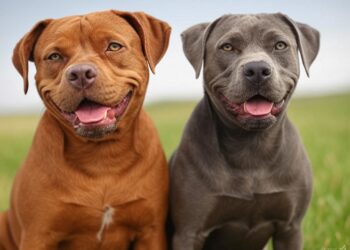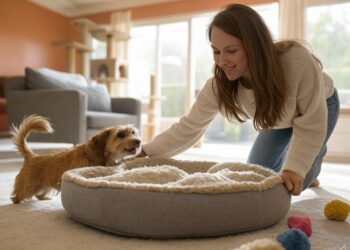You have decided to get a dog as a pet. Of course, there are a number of things to consider and it is a choice that should be carefully considered. Do you want a small or large dog? Which race? And are you taking a puppy or an older dog?
Choose a puppy
If you choose a puppy, there are a number of things to consider. A puppy takes more time in the beginning than an adult dog. Think of potty training, learning to walk on a leash, and unlearning unwanted behavior. After all, a puppy knows nothing and still has to learn everything.
A puppy must also be vaccinated, dewormed, and chipped. For example, a puppy quickly gets used to contact with other dogs and people, but also to the sounds of cars, trains, and seeing cyclists.
A puppy with children and other pets
If you have children or other pets, getting a puppy is an advantage. The puppy then immediately learns to deal with children and other animals. Please note; never leave your children alone with a dog! Especially in the beginning, the puppy can bite playfully on a regular basis, and unfortunately, they do not only limit this to the hands.
Children are often very enthusiastic with a dog and can therefore unconsciously hurt the dog, causing the dog to bite. Remember that the puppy and the children both need to learn to interact with each other. Therefore, teach your children from day one to deal with the puppy calmly and that the puppy should be gentle with the children.
Reading suggestions; Black Dog Names; 400+ Names for Black Dogs
older dog
If you prefer an older dog that already knows the basic commands, you will end up at the animal shelter. Dogs regularly end up here whose owners can no longer take care of them, or whose owners have died. Always inform the animal shelter employee of the home situation, such as children or other pets.
Not every dog is used to this and some dogs, for example, do not get along at all with other dogs or cats. So be well informed and don’t just rely on a sweet appearance.
An advantage of older dogs is that they are usually well housebroken, walk well on a leash, or can even walk well off-leash.
For example, if you work, an older dog will require less time than a young puppy that still has to learn everything, including being home alone. This does not alter the fact that every dog needs his attention and needs to be walked.
Necessities
A dog needs a number of things in daily life. Think of a water and food bowl, a rug, pillow or basket, toys, and a belt. Many dogs also enjoy being able to chew on something, especially a slightly younger dog. Think of chewing bars made of bovine leather. These are available in different sizes and thicknesses, so you can adapt this to the size and bite needs of your dog.
Enough space
If you want a dog, also consider the space you have to offer a dog. For example, do not put a large dog in a two-room apartment. Large dogs need space to move around, especially if the owner has to work during the day. A small dog is more suitable for this.
If you are considering getting a slightly larger dog, make sure that he is walked regularly and that there is a special dog walking field nearby, so that your dog can run free and lose his energy better. The more a dog can expend his energy outside, the calmer he is in the house.
Reading suggestions; The 6 Best Dog Beds
It is important that a dog is not only stimulated physically but also mentally. Think of hiding treats in the house or outside, a food ball in which food is put and that the dog has to get it out itself. You can also opt for a dog sport that alternates between mental and physical stimulation.
Types of dogs
Dogs are classified under different breed groups.
Sheepdogs and drovers
Think of the sheepdog and the border collie. The dogs that fall under this group are often used to herd livestock and hunt. The hunting instinct is already present in these dogs from birth. They are loyal to the owner and the family but need a firm hand and a boss who is consistent.
They are strong dogs and therefore not suitable for being walked by young children. They need a lot of exercises and must be kept both physically and mentally stimulated or the dog will be unhappy. These dogs are ideal for living on, among other things, a farm.
A disadvantage can be that if you let them run loose, they suddenly stick their nose in the wind and run away. This is because they smell something and they chase after it, this is their instinct.
Pinchers, Schnauzers, Molossers, and Swiss Mountain Dogs
Pinchers and Schnauzers have a good hunting instinct and are good watchdogs and are very attached to their own family. They can bark a lot towards strangers and are somewhat suspicious. With good guidance, especially from a puppy, this is very easy to keep under control. 
They are smart dogs and learn very quickly. Molossers are large and strong dogs, think of the Great Dane, Dogue de Bordeaux, and the Cane Corso. These are generally calm and independent dogs that also bond with the family. These dogs have a great bite force and often hold onto.
They are not easily angry and can take a beating. These dogs do not learn quickly, and therefore need a confident owner and clear guidance. The Mountain Dogs are very strong dogs and well suited for herding livestock and guarding the home.
terriers
These are good hunting dogs and have a lot of energy. They are brave and tenacious and will often kill their prey themselves. They are independent and stubborn dogs that do not always get along well with other dogs. They can bark a lot because they are so watchful, so not recommended if you live in an apartment, for example.
A clear and consistent boss is certainly necessary for this breed group. It is advisable to teach these dogs to interact with other dogs as much as possible from an early age. They are very affectionate with other people and especially their own family.
Dachshunds
This refers to the Dachshunds. You have them in short-haired, wire-haired, and long-haired. They are originally very courageous dogs that like to bark and are independent dogs that learn very quickly.
Socialization with these dogs is very important, especially with children and other dogs, otherwise, the dogs can become nervous and show fear aggression. Don’t be fooled by the small size of these dogs; a consistent and strict upbringing is necessary!
If these dogs are not used for hunting, it is very important to keep an eye on these dogs when chasing, for example, ducks or cyclists.
Spitz and primal types
This refers to the husky, Scandinavian hunting and herding dogs, and the Keeshond. The huskies are group dogs and do not like to be alone. They prefer to be with another dog.
They are often a bit distant towards other people. These dogs usually don’t like to cuddle and like to be high in the ranks. Because they are fierce hunters, it is not recommended to let them run free without proper guidance. The Scandinavian hunting dogs are idiosyncratic and have very high stamina, sufficient exercise is a requirement for this breed.
They are very active and bond very quickly with the family and learn quickly. The Keeshond is a watchful dog that quickly becomes attached to its own family. They bark a lot and learn very quickly. The Asian Keeshond is aloof and quick to learn, but training these dogs takes a lot of time due to their idiosyncrasy. The European Keeshond is generally more affectionate and easier to train than the Asian Keeshond.
Running dogs and sweating dogs
These dogs are also often used in hunting in which they track and driving games. Think of the Dalmatian dog and the Rhodesian Ridgeback. The dogs from this breed group have a particularly highly developed hunting instinct due to their very strong nose.
They are pack animals and therefore like to be with another dog. These dogs always follow their noses and therefore difficult to let go of. Learning how to come here is highly recommended.
They are very enthusiastic about people, especially when they are young. It takes a lot of time to properly raise these dogs and they need a lot of social contact with other dogs and people.
Standing dogs
This breed group includes the German Shorthaired Pointer, Partridge Dog, Irish Setter, and Pointer. These are also good hunting dogs, but very easy to train by the owner. These dogs often don’t rush to prey like other breeds of dogs, but often wait for a signal from the owner.
They are sweet and sensitive dogs that bond well with their families. A lot of exercises is needed in these dogs and they like to work together with their owner. They are willful dogs but learn quickly.
Retrievers and Water Dogs
The Labrador Retriever and Golden Retriever like to work with the owner and are fond of retrieving. They generally remain playful longer than other dog breeds and therefore often mature somewhat later. They are very social and affectionate and love the family.
They have great stamina and love water. Always teach them to enter the water on command in connection with ducks or other games.
Company dogs
Actually, these dogs were bred to keep humans company. The breeds that fall under this are the bulldog, poodles, Maltese, and the Cavalier child Charles spaniel. This breed group is very attached to the owner and family and therefore likes to stay close.
This can sometimes cause problems if the dog has to stay home alone. They are playful, sensitive, and sweet. However, they can also be very watchful and therefore bark a lot.








